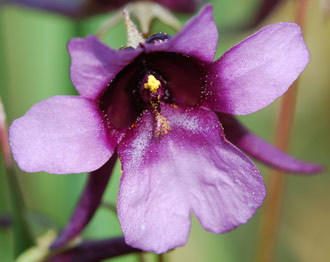Diascia insignis
Diascia insignis K.E.Steiner
Family: Scrophulariaceae
Common names: horinkies (Afr.)
Introduction
Diascia insignis, with its beautiful tiny reddish-purple flowers, is known only in and around Nieuwoudtville.

Description
Description
Diascia insignis is an annual herb. The stems are approximately 210 mm long and the basal leaves can be few or many. Between one and four slightly spicy-scented flowers can be found per stem. The upper corolla lobes are reddish-purple, but darker than the others and with dark red lines at the base. The other lobes are similar in colour but don't have the red lines.
The flowers of D. insignis are characterized by two long spurs and two depressions at the base of the upper corolla lip. The flowers secrete floral oil and are self-incompatible.
Flowering is normally from August to September, but the plants only appear in years of above-average winter rainfall. They are dormant during the summer months.

Conservation Status
Status
Diascia insignis is classified as Vulnerable.
Distribution and habitat
Distribution description
Diascia insignis has a very restricted distribution. It is known only from the Bokkeveld escarpment near the village of Nieuwoudtville in the Northern Cape, and occurs in the Nieuwoudtville Wild Flower Reserve, in the Hantam National Botanical Garden and on the farms Oorlogskloof and Matjiesfontein south of the village.
It grows only on tillite soils in renosterbos vegetation under or between shrubs, and it only appears in years of above-average winter rainfall.
Derivation of name and historical aspects
History
Diascia, the genus name meaning two sacks (spurs), is derived from the Greek diaskea = to adorn. The species name insignis is Latin and means remarkable, distinguished and noticeable.
Ecology
Ecology
The flowers produce oil and are pollinated by oil-collecting bees. Stamens are situated between two floral spurs forcing the bees to straddle the anthers to insert their forelegs into the spurs. Using specially modified setae on their front legs, the bees mop up the oil secreted by the oil glands within the flowers. As the bees press against the anthers pollen is transferred to their bodies.
Growing Diascia insignis
Grow
Diascias are fun to have in a garden and one can plant them as ground cover or in a border. They can also be planted in containers, on their own or with other plants such as Felicia species.
The more than 70 species, all indigenous to South Africa, flower in colourful abundance and give so much joy that it is worth considering planting them in your garden. These dainty flowers can be planted in full sun during autumn, although they will grow in the shade of bushes and other shrubs. Most Diascia species tolerate modest frost. They are easy to grow and are disease-resistant.
Plant them in well-drained soil in full sun or semi-shade. For vigorous growth and lots of colour, plant in compost-rich soil and fertilize regularly with liquid fertilizer, or granular fertilizer high in potassium. A handful per square meter will be sufficient. Do not use too much fertilizer as the plants will then produce more foliage than flowers. Water regularly even though they can tolerate periods of drought. Regular watering will prevent flower drop and scruffy growth.
References
- Hilliard, O.M. & Burtt, B.L. 1984. A revision of Diascia section Racemosae. Journal of South African Botany 50: 269-340.
- Kampny, C.M. 1995. Pollination and flower diversity in Scrophulariaceae. Botanical Review 61, 4, Oct -Dec., 1995. Springer, New York Botanical Garden Press.
- Steiner, K.E. & Whitehead, V.B. 1990. Pollinator adaption to oil-secreting flowers - Rediviva and Diascia. Evolution 44: 1701-1707.
- Steiner K.E., Two new Diascia (Scrophulariaceae) species from the Nieuwoudtville area western Cape, S.Afr.J.Bot.,1992,58(3):202-206
- Steiner, K.E. & Whitehead, V.B. 1991. Oil flowers and oil bees: further evidence for pollinator adaption. Evolution 45: 1493-1501
Credits
Colleen Rust
Hantam National Botanical Garden
February 2012
Plant Attributes:
Plant Type: Bi/Annual
SA Distribution: Northern Cape
Soil type: Clay
Flowering season: Winter
PH: Alkaline
Flower colour: Purple, Mauve/Lilac
Aspect: Full Sun, Morning Sun (Semi Shade), Afternoon Sun (Semi Shade)
Gardening skill: Challenging
Special Features:
Horticultural zones








Rate this article
Article well written and informative
Rate this plant
Is this an interesting plant?
Login to add your Comment
Back to topNot registered yet? Click here to register.